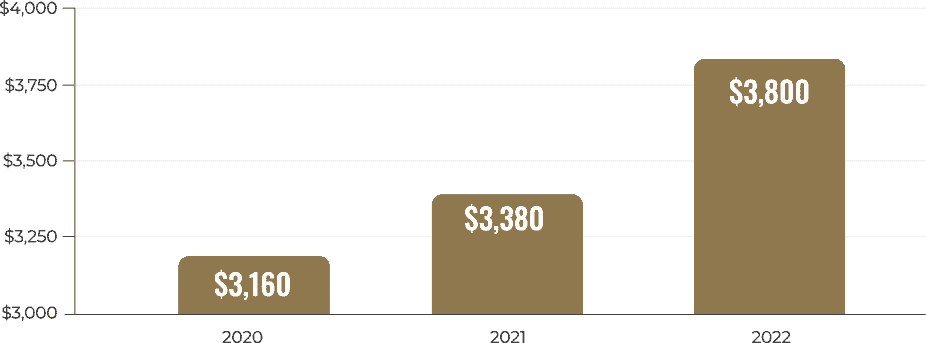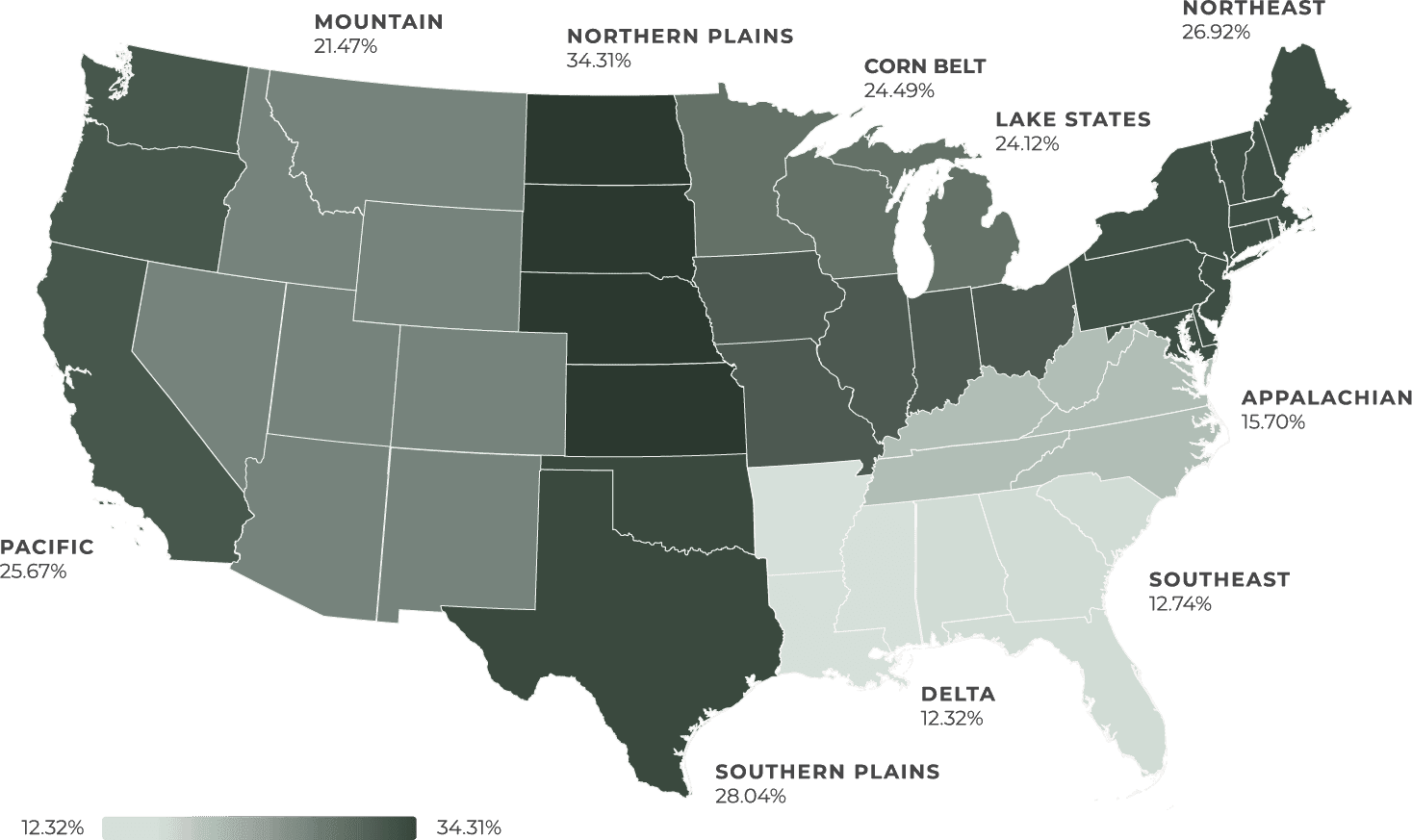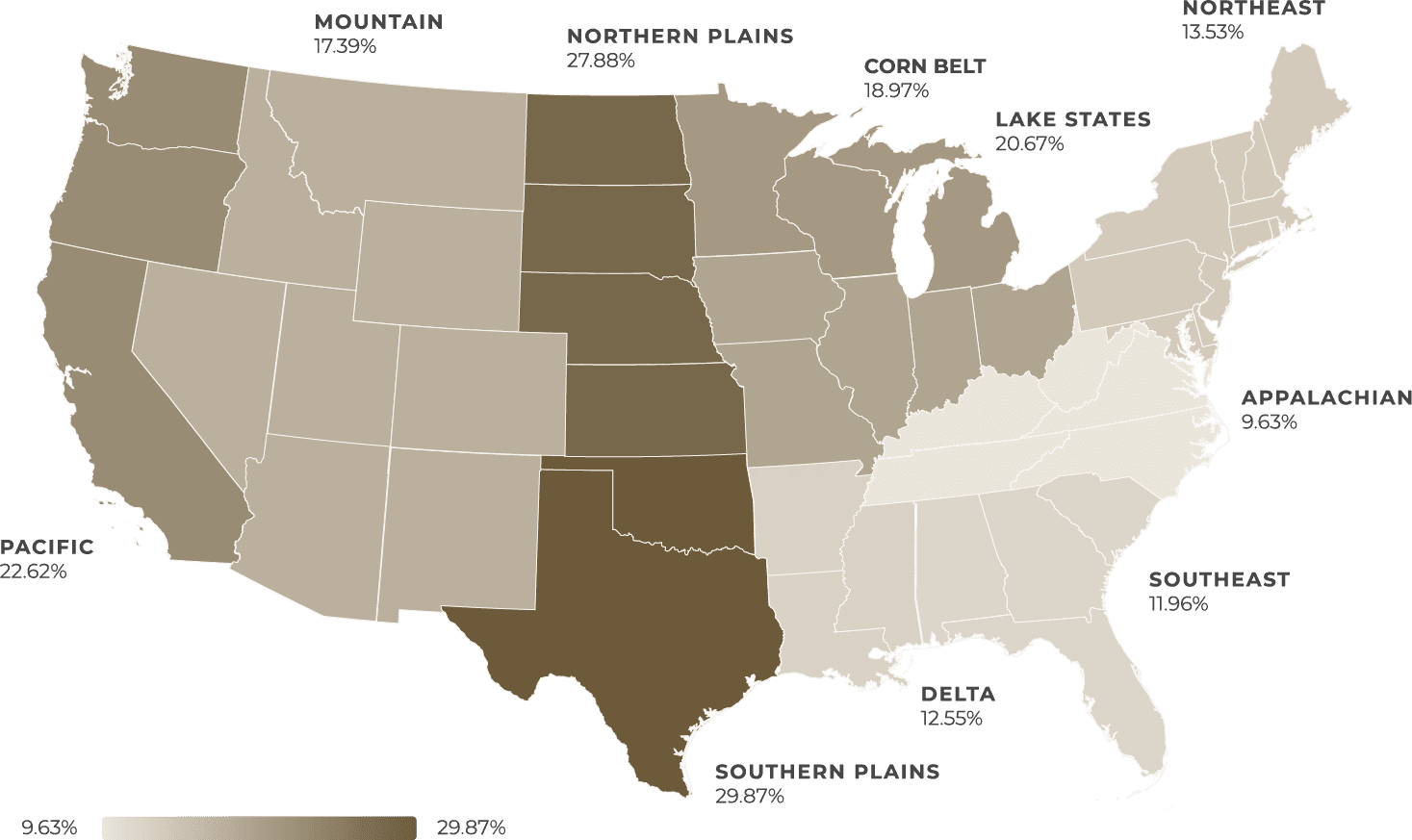The Relationship Between Farmland Values, Interest Rates, and Inflation
The U.S. Farmland Real Estate Market in 2022
Despite rising interest rates and input costs, the 2022 farm economy is experiencing positive growth due to strong net farm income, liquidity, and higher cash rents. However, higher cash rents are tightening margins for tenant farmers.
Throughout this uncertainty, AgAmerica’s economists Dr. John Penson and Dr. Cliff Shelton have been monitoring the current land market and further explored the relationship between farmland values, interest rates, and inflation with the release of the 2022 USDA Land Values Report.
Table of Contents
Silver Linings in the 2022 Farm Economy
Understanding the Historical Relationship Between Farmland Values and Interest Rates
Farmland Values and Interest Rates in 2022
Major Drivers of Farmland Values
Financing Opportunities Amid Rising Interest Rates
Silver Linings in the 2022 Farm Economy
According to the Purdue Ag Economy Barometer (and most farmers you speak to), there is a strong sense of uncertainty about the farm economy right now, including the future of farmland values. From spiking input costs to ongoing drought conditions, a multitude of obstacles are challenging American farmers and ranchers today.
Even in the face of rising interest rates and higher input costs, the 2022 farm economy is relatively strong when compared to the challenges experienced during the 1980s financial crisis. While there is a resemblance to the 1980s in terms of rising interest rates and inflation, current interest rates are not expected to come close to the double-digit interest rates that occurred during that decade.
Despite current challenges, the 2022 land values report by the USDA revealed once again that 2022 marks back-to-back record highs in cropland values.
“Despite the rising cost of farm inputs, the farm economy is still in a strong position, historically speaking. Net farm income may be down 4.5 percent from last year, but it remains well above the average over the past 12 years. And while the Federal Reserve has recently raised its target rate to 2.5 percent, this pales in comparison to the 16 percent high during the financial crisis of the 1980s.”
Dr. John Penson, Chief Economist at AgAmerica
In addition to strong farmland values, Dr. Penson highlighted other measurements that attest to a strong farm economy.
- Farm Income: The USDA projects a net farm income of $113.7 billion in 2022. Although this is down 4.5 percent from 2021, it is still 24 percent above the 2010 to 2021 average.
- Liquidity: In addition to a strong net farm income, working capital is also strong, equipping farmers with greater purchasing power.
- Cash Rents: Another indicator of economic health, cash rents for farmland are up 10 percent or more in some areas. However, while this is beneficial to the landowners, this is increasing the cost of yet another input for the farmers who are paying cash rents.
All that to be said, it will be important for farmers, ranchers, and rural landowners to be cautious and strategic when planning expansion and land acquisition projects. Carefully examining one’s own financial health and the external economic environment is critical to sound business decisions.
Understanding the Historical Relationship Between Farmland Values and Interest Rates
While we are nowhere near the levels of rising interest rates and inflation in the 1980s, there are parallels between that time period and the current interest rate environment.
When asked about the historical relationship between farmland values and interest rates, Dr. Penson shared that there are only seven instances where farmland values declined since 1950.
The first four of these decreases occurred during the financial crisis of the 1980s. In 1981, the federal funds rate peaked at 16.3 percent in comparison to the current effective rate of 2.3 percent. In fact, the federal funds rate averaged 11.5 percent over the period covering 1981 to 1985. In addition, the core inflation rate during that time period was 12 percent in comparison to 5.9 percent, where it sat in the second quarter of this year.
The next time farmland values declined was in 2010, following the 2007 to 2009 Great Recession and the ensuing instability in global financial markets.
The final decrease occurred from 2017 to 2018 after net farm income fell 24 percent in 2016 followed by relatively low net farm income over the balance of the decade.
It is important to note that these periods of decline are outliers. Throughout history, farmland values have typically increased from one year to the next.
Farmland Values and Interest Rates in 2022
The rising interest rate environment hasn’t kept farmland values from increasing—in fact, according to USDA data, land values are continuing an upward trajectory.
Farmland Real Estate Value
(average per acre)

Cropland Value
(average per acre)
Source: USDA Land Values 2022 Summary
Pastureland Value
(average per acre)
Source: USDA Land Values 2022 Summary
Interest Rates
To curb inflation, the Federal Reserve raised the target range for the federal funds rate by 75 basis points to between 2.25 percent and 2.5 percent in its July 2022 meeting, making it the fourth consecutive rate hike this year.
As of August 2022, the effective federal funds rate is 2.33 percent. According to Dr. Penson, the futures market currently expects this to peak around 3.4 percent, a far cry from the 16.3 percent seen during the 1980s.
Land Values Remain High Despite Rising Farmland Interest Rates
Rising farmland interest rates may lead to a decline in the rate of farmland value increases, but they are not expected to cause farmland values to decrease.
“I fully expect an upward trend in land values to moderate in 2023. Based on the strength of farm balance sheets and continued nonfarm investor interest, I do not anticipate land values nationally to decline.”
Dr. John Penson, Chief Economist at AgAmerica
Amid economic turbulence, strong farmland values are a driving force behind farmland investment and the benefits of owning land.
Jackson Takach, Farmer Mac’s Chief Economist, explained how rising interest rates could impact farmland investment by adding to the variables investors consider when they analyze long-term impacts of investing.
“Higher interest rates raise the cost of capital for farmers, either existing farmers, people who want to get into farming as an investment, or as a new farmer.”
While it’s difficult to predict exactly what farmland values will look like the following year, the fourth quarter and first quarter of the next year may provide the best insight into their direction. This is because farmers are typically focused on harvesting and marketing during the third quarter, so farmland values are generally inactive during this time period.
Below are several indicators that will impact the future of U.S. farmland values.
Major Drivers of Farmland Values
1. Quantity of Farmland Available for Sale
The market for farmland is highly sensitive to the quantity of land available for sale. Farmland is typically held for long periods of time compared to other forms of equity investments and may be traded within families.
We have lost 25 percent of farmland since 1950. Due to urbanization and the finite nature of farmland, it is and always has been a scarce resource. Between 2001 and 2016, U.S. farmland was lost at a rate of 2,000 acres per day. Like other scarce resources, prices get pushed up due to the basic laws of supply and demand.
In addition, the increase in global hunger coupled with recent events such as geopolitical tensions, drought, and a growing population make farmland a highly valuable resource—and a crucial component of the global food supply.
“It is urgent we safeguard the land that grows our food.”
2. Farmland Demand
Another variable supporting the continued increase of farmland values is strong demand for farmland. When farmland does come on this traditionally thin market, the bidding by farmers and nonfarm investors can cause farmland prices to rise substantially. According to Dr. Penson, farmland has yielded an approximately 3.5 percent rate of return plus potential capital gains in recent years. When compared to other investment opportunities such as the stock market, farmland investment provides greater stability in total returns over time.
“Demand for land is and will remain strong, as nonfarm investors are seeing the long-term and stable returns that come with investing in farmland.”
Dr. John Penson, Chief Economist at AgAmerica
In addition to demand from nonfarm investors looking for stability, there is also demand from farmers and ranchers seeking operational expansion.
3. Cash Rents
Capitalized land values tend to move in the same direction as cash rents. As cash rents increase, land ownership becomes more attractive.
4. Interest Rates
Rising interest rates increase the cost of borrowing capital. As a result, a softening in the rate of increase for farmland values is to be expected.
5. Inflation
During times of high inflation, farmland ownership becomes even more attractive to investors due to its ability to hedge against inflation.
6. Geopolitical Tensions Affecting International Trade
Supply chain disruptions caused by conflict such as the war in Ukraine can impact commodity prices. In addition, America’s trade relationship with China also has a significant impact on commodity prices, as China is a major importer of U.S. farm commodities.
7. Location
There are regional variations in terms of farmland values across the U.S. For instance, the Pacific and Northeast regions tend to see some of the highest farmland values while the Southern Plains and Mountain regions tend to skew towards the lower end.
8. Soil Quality
Greater quality land with higher productivity translates to higher land values. As more farmers adopt conservation practices, many are seeing improvements to soil quality. Over the long-term, higher quality land not only leads to higher yields but also supports higher land values.
Financing Opportunities Amid Rising Interest Rates
While you can’t control rising interest rates and input costs, you can control the way in which you manage your finances.
When examining your operational finances, it’s a wise idea to review the terms of your current debt and analyze your balance sheet to assess if restructuring farm debt or increasing working capital would provide liquidity to help your business grow. Being proactive by locking in input prices early and making strategic decisions like crop choice can also help hedge against inflation.
As interest rates are expected to continue rising, securing financing could help you expand your operation to increase efficiency and minimize expenses.
Whether you’re looking to expand your operation, purchase leased land, refinance existing farm debt, or all of the above, AgAmerica is here to help along the way.
Explore AgAmerica’s loans to finance land purchases that contribute to long-term financial stability.








